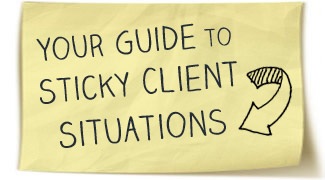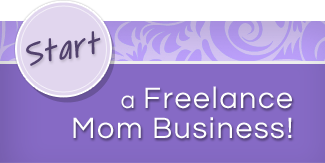
I have met more moms recently who, if they had the chance or opportunity, would choose being a work-at-home mom over employment in corporate America.
If you are reading this, then you are one of the moms in the world who do want to work from home rather than deal with strenuous commutes, office politics, long hours and wasted office time. After all, recent small business statistics have shown that women are starting businesses 15% more often than men.
But what about moms who’ve been there and done that in the self-employment arena?
What about those who have ditched corporate for self-employment, then ditched self-employment back to corporate? Does that really happen and if so, why?
Yes, it seems it does happen and we found out two main reasons why.
Even better, we’ll show you how to do your best to prevent it from happening to you.
Problem #1: Financial Uncertainty
When you’re self-employed, there’s always a financial uncertainty looming somewhere overhead. This is because at any given time your business could begin to struggle and you are usually the one who has to deal with keeping it afloat.
Yet for most women, this fear is soothed by the flexibility that self-employment offers. It’s a trade-off, really. More flexibility, but also more worry.
But what happens when the fear of struggle actually becomes real? Then is the flexibility worth it?
This is exactly what happened to Heidi, who wishes her last name be kept anonymous.
Heidi started a business right after her first daughter was born. Shortly after starting it, her husband joined in with her and they ran a successful business together.
Three years later, as the economy started slipping downward, Heidi said that she and her husband spent just as much time chasing invoices as they did managing the business.
Therefore, facing financial uncertainty, Heidi accepted a job with a client and has been there since, leaving her aspiration of lasting self-employment.
“The bank doesn’t care if you are waiting to get paid when they come looking for the mortgage payment,” said Heidi.
The Solution:
The reality of what happened to Heidi can become a reality for anyone. However, what you can do is minimize financial uncertainty and maximize chances for success by taking advantage of a few strategies.
To succeed financially as a self-employed individual, here’s what you should do:
- Have a consistent savings in place. Having a savings in place in order to pursue self-employment is very important. Having a savings in place throughout self-employment is even better. As you make money, save it. Business fluctuates so you’ll need to always have a cash reserve so that you don’t have to worry about where your next mortgage payment is coming from during slow months.
- Always be frugal. From the moment you decide you want to be self-employed, put on your penny-pinching hat. Rather than pay an agency to create your website, do it on your own or hire a freelancer. Rather than pay an interior designer to spruce up your boutique, do it yourself or hire a friend. Buy less expensive paper. Use your personal cell phone for business. There are always more frugal ways of doing things, you just have to be willing to look for them.
- Do your homework if you decide to borrow money. If your business goes bad, you still have those loans to pay. Now just imagine what you would do if your business did go bad and you were $10,000 in debt from a business loan with no employment to speak of. Make it a priority for your business to DIY as much as possible and if you feel you have to borrow, borrow in small increments that you’re sure you can pay off right away.
- Eat bites of the pie, not the whole thing. Some people get so excited at the thought of their businesses that they want to make it perfect right at the start. Reality check – unless you’re a millionaire, it’s not going to be. It’s important to start small and bite off small chunks of your ideal business one day at a time. This way, you’ll ensure that you’re making money before you’re spending it. It’s a lot easier to get back into financial balance from a small debt than a large debt.
Problem #2: Retirement Uncertainty
One of the biggest obstacles facing work-at-home moms and other self-employed individuals is a cushiony retirement plan. Without an employer match and income that can be anything but steady, saving for retirement can be a huge burden for the self-employed.
Meet Justine tenZeldam.
Justine tenZeldam has made the transition from self-employment to corporate and back again several times, all for different reasons.
Recently, she left her self-employed consulting job in Sacramento to pursue business development, sales and social media at Tactical TeleSolutions in San Francisco.
Besides Sacramento being an economically depressed location, Justine transitioned back to corporate because she wanted to make sure she’d be able to happily retire when the time came. This is something she couldn’t guarantee would happen if she stayed in the consulting field within a depressed economy.
Justine is like many other business women who remain within or return to the corporate culture in order to guarantee retirement when the time comes. For her, retirement, among other factors, outweighs flexibility of self-employment at this point in her life.
The Solution:
Going back to corporate to cushion a retirement fund is logical. Despite how great self-employment is, we all want to retire one day. So what’s the best solution so that you can be successfully self-employed and still save for retirement? There are two solid retirement choices to choose from that are perfect for work-at-home moms who are eager to be solopreneurs, and you can read more about them in a detailed article in Forbes.
- Individual 401(k): This plan offers munificent contribution limits, flexible contribution amounts and the ability to take out loans up to half the account’s balance if needed (which you shouldn’t do unless it’s in very small amounts, but the option is there).
- SEP-IRA: This option allows you to set aside pre-tax savings, contribute up to 25% of net self-employment income and offers flexible contribution arrangements, such as waiting until tax season to supply funds.
What Does This Mean For You? What’s Really the Better Choice?
Whether you decide to remain in corporate, pursue self-employment or transition back and forth, the choice to do so is yours and yours alone.
Each woman is entitled to select the option that works best with her personal circumstance.[Tweet this]
If you don’t think you can deal with financial uncertainty, don’t want to forgo the chance of a guaranteed and lofty retirement plan, or don’t think you can deal with other uncertainties that accompany self-employment – that’s okay. You have to do what’s best for you.
As far as Heidi is concerned, now that the economy is improving, personal fulfillment might win out in the end again. She’s like many women today who are realizing that balance and time with children is paramount to any size rung on the corporate ladder. For Heidi, the ultimate decision is about doing your best to strike a balance in any situation.
“Our kids only grow up once,” said Heidi. “No one has ever engraved on their tombstone – I wish I had spent more time at the office.”
Is this You?
Have you experienced any of these challenges? What are you doing to reduce your odds?





